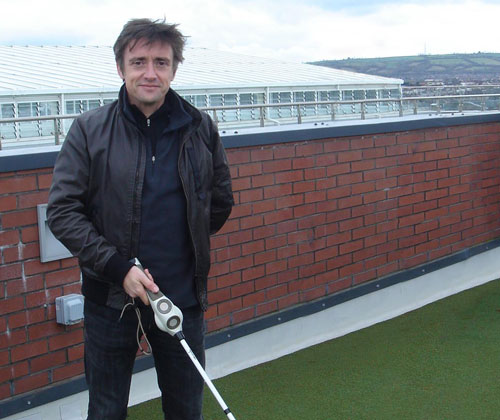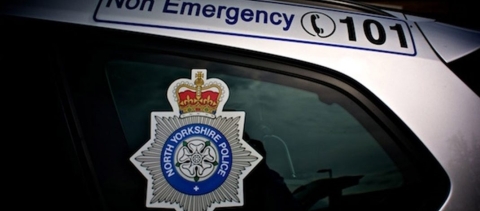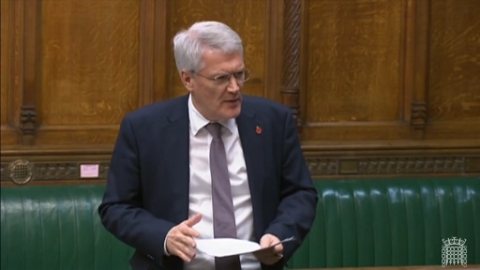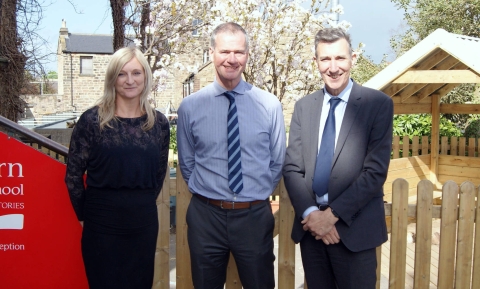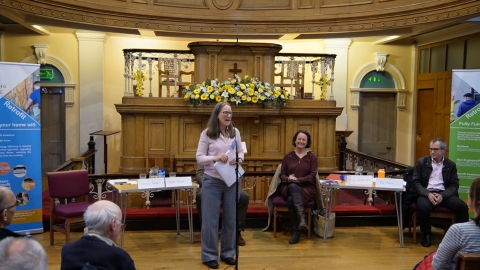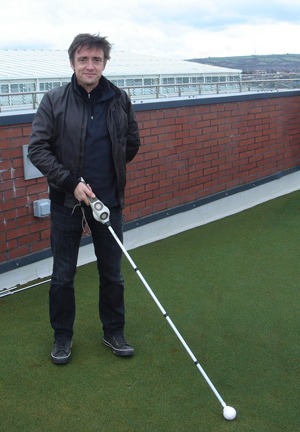 Bat sense reinvents white cane, powering users to new levels of mobility.
Bat sense reinvents white cane, powering users to new levels of mobility.
UltraCane aid for the blind hailed as Miracle of Nature by BBC programme
The UltraCane, a revolutionary, electronic mobility aid which helps blind and visually impaired people to ‘see’ in a different way, plays a starring role in BBC1’s new prime time series Miracles of Nature.
Fronted by daredevil presenter Richard Hammond, the second programme, shows how the navigational abilities of bats have been copied to give blind people a new found ability to detect and avoid obstacles.
Hammond marvels at how an Egyptian fruit bat is able to fly between narrowly placed wires before he dons a blindfold to better understand how the same echolocation ability can help a sightless person build a ‘mind map’ of their surroundings.
Hammond uses the UltraCane to negotiate his way safely around a series of obstacles and soon realises his success is not down to luck, but the ability of the human brain to adapt.
Hammond said:
The remarkable thing is how quickly the human brain adjusts to allow us to use our senses in a completely different way. This technology allows me to ‘see’ with my brain – not my eyes.
The UltraCane works by warning users of obstacles in their path and at head height through tactile signals received through the handle. www.ultracane.com
The UltraCane’s tactile feedback stimulates the mind mapping ability of the brain. Over time, users find they no longer need to focus their full attention on the tactile information and can use their other senses when they walk around, much as sighted people do.
Bats use echolocation to send out ultrasonic pulses. By measuring the time from emission to receiving the echo they are able to build a picture of their environment which allows them to safely find their way around obstacles in the dark.
In order to imitate this process the handle of the UltraCane is a handset fitted with transmitters and sensors. Buttons in the handle vibrate when the sensors detect that an obstacle is near. The strength of the vibration indicates the proximity of the obstacle, helping the user to walk around it easily and independently.
Programme makers were so impressed by the use of the technology they approached experts from Sound Foresight Technology, the developers of the UltraCane, to help them fit the same electronic components to a standard mountain bike.
The aim was to create an experimental UltraBike, designed to help blind cyclist Dan Smith negotiate his way along a woodland cycle path.
Aeronautical engineering student, Dan, aged 20 is one of twin brothers affected by the rare genetic disorder Leber’s Optic Neuropathy and lost his sight a few months ago.
Dan said:
I tried out the UltraCane on a street setting and the benefits of ultrasound technology were immediate. As soon as I realised that the UltraCane was protecting me from bumping into posts or parked cars, my confidence grew. As a blind person it was a great feeling to be able to walk around without feeling nervous.
Technically the use of ultrasound technology to help blind cyclists is a possibility – a blind cyclist in California, has been doing something similar for some time.
Electronics engineer Dr Paul Clark, a director of Sound Foresight Technology commented:
The UltraCane completely overturns the idea that a visually impaired person’s experience of the world is defined by and limited to, an inability to see.
Blind UltraCane users all over the globe are leading full and active lives because they can move around confidently and safely. This technology effectively gives them a new sense and a different way to experience the world.
BBC1’s Miracles of Nature series features examples of Biomimetics, which is the transfer of materials and techniques developed over millions of year to 21st century technology and engineering.

